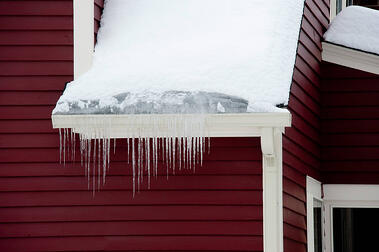Eliminate Ice Dams To Avoid Costly Drywall Repair Bills
Jeremy Holderness Invariably, after the first significant snowfall hits, frustrated homeowners are forced to call-in a local painting company to repair and repaint water-damaged drywall on ceilings and walls caused by ice dams.
Invariably, after the first significant snowfall hits, frustrated homeowners are forced to call-in a local painting company to repair and repaint water-damaged drywall on ceilings and walls caused by ice dams.
Ice dams form when melting snow from a warm roof re-freezes near the gutters to form an icy ridge - causing a traffic jam that keeps the remaining melted snow from properly draining off of the roof and into the gutters.
Often times this backed-up water from the melting snow will find its way under your shingles, into your attic, and eventually into your living space; causing a range of problems from unsightly water stains on your ceilings to roof decay and even mold growth.
However, you can avoid a hefty drywall repair or roof repair bill by taking some precautions to make sure ice dams don't become a problem during the Winter weather months.
The Culprits
Simply put, ice dams are caused by the temperature of your roof being greater than the temperature of the outside air.
Unless you have a conditioned living space in your attic, it is designed to maintain a temperature similar to that of the outside air. If you have turned your attic into living space -- well, then that's a different conversation for another time.
If you do have a conventional attic space then your ice dams are probably caused by one or more of these common issues:
Common Problem 1: Having less than the recommended amount of insulation in your attic will allow the conditioned air from inside your living space to make its way into the attic space and cause the roof to warm.
Common Problem 2: Improper/inadequate attic ventilation will not allow enough outside air to be drawn in from the eave vents, allowing any heat that makes its way into the attic to escape through the ridge vents.
Common Problem 3: Bathroom and kitchen exhaust fans that are ventilated into the attic rather than to the outside of the home will introduce conditioned air into the attic space causing the same situation.
The Fixes
Keep the 'Bought Air' In - By adding the recommended amount of insulation in your attic you'll not only keep the space cooler but you'll reduce your energy bills because your conditioned air will stay where it's supposed to.
A frequently overlooked area that often doesn't get insulated is the area directly above the attic access door in your ceiling. Fortunately there are some good solutions for that too.
Also check to make sure that the ceilings/attic floor has a vapor barrier installed between the drywall/plaster and the insulation. A vapor barrier can be in the form of plastic sheeting or a paper facing that's attached to the insulation. Either way it will keep the moisture in your home from escaping into the attic and causing damage or mold build-up.
Let Your Attic Breathe - The best way to ventilate an attic space is to have an unobstructed flow of fresh air coming in and going out. When vents are properly installed in your soffits under the eaves, as well as in the ridge at the peak of your roof, it creates a natural draft which pulls cool air in from the bottom and releases the warmer air out through the top.
The most common thing that obstructs the air flow is when attic insulation covers up the soffit vents. An easy fix is to install some insulation baffles which protect the soffit vents from being accidentally covered by the insulation.
Another common problem is when someone adds additional vents in the attic (i.e. gable end vents) that can actually do more harm then good by disrupting the natural air draft from the soffits to the ridge. Contact a trusted building contractor if you have multiple types of ventilation in your attic and you suspect this could be contributing to your ice dam problem.
Seal The Holes - When builders drill holes in the attic floor to run pipes or wires down into the home it's not unusual for them to forget to seal the gaps around the pipes/wires to keep the conditioned air from leaking into the attic. Some fire-stop caulking will work great to fix any potential air leaks.
Exhaust To The Outside - Make certain that any exhaust pipe, like the ones coming from your bathroom fan or kitchen range hood are being properly exhausted to the outside of the house and not into your attic space. Not only does this dump conditioned air into the attic but also moisture.
Insulate Your Ductwork - Finally, if you have any ductwork in your attic make sure it is properly sealed and well insulated. Leaky or uninsulated ductwork can add a significant amount of conditioned air into your attic space.
Exercise Good Judgment
Many people are injured each year by attempting to remove ice dams. THIS IS NOT A DIY PROJECT! Attempting to remove ice dams can damage your roof and your gutters, and can cause you serious bodily harm.
The best thing you can do is setup a couple of box fans in your attic, pointed at the underside of the roof where the ice dams are forming. This cool airflow should slow down or stop the ice dams from getting worse.
Now that the situation is stabilized, call in a professional who can safely remove the excess snow from the roof and keep any water from the melting snow from getting under your shingles and into your home.
If you're in the Greater Pittsburgh or Western Pennsylvania areas and you need assistance repairing water damage from ice dams, contact us below.
Image by: photofarmer / CC BY 4.0








